- About us
- Contact us: +1.641.472.4480, hfi@humanfactors.com
Cool stuff and UX resources
Introduction
As part of my own User Experience (UX) effort to get the pulse of what you would like to read in this newsletter, I posted a request for topics on HFI Central and HFI Connect.
Arun Martin, from Bangalore, picked up the challenge. He was new to UX, but also a recent CUA graduate, having worked previously in tech support and tech writing. He sent the following:
My *assignment* is to: Offer user research methods as a bundled offering or as an individual offering to the customers. That's the easiest part. The toughest part is to prepare the cost benefit analysis of each user research method.
For example, company X approaches to engage us for a Contextual Interviews (CI) exercise for their product. How do we come up with a quote stating the CI will help the company X financially and also ensure decent profitability margins for my company?
What might be the components of each user research method to be looked into before we prepare a quote? I'm working at a UX design firm and a vast majority of our consulting work is about designing better UX experiences for websites.
These are very important questions. Imagine you were a new hire, asked to come up not only with marketing justifications, but also pricing and profit policies? Arun listed their planned offerings:
- Card sorting
- Individual interviews
- Diary studies
- Cultural probes
- Contextual interviews (CI)
- Online surveys
- Focus groups
I guess I'm talking about the ROI of each user research method for each customer, but not sure how to get started. Please correct me if I'm wrong. I did see a ROI calculator on the HFI site, but not sure whether it applies to my question.
Now, I want to provide as much value in this UI Review possible. So, my first offering to you must be the signature line that Arun has placed at the bottom of each email
When God takes something away from your grasp, He is not punishing you. But He is merely emptying your hands, for you to receive something better.
This was an inspirational sentiment as I embarked on synthesizing my own 20 years of consulting under the leadership of Eric Schaffer at Human Factors International. I also benefited considerably from the advice of a former CUA course participant and now colleague, Michael Rawlins.
Here's my reply. I will follow it with a recent online publication on the value of "visualization". That's because this UI Design Newsletter actually presents the "BIG PICTURE" on selling your UX services.
We all need a BIG PICTURE in mind for UX services because it defines and confirms our own important role in keeping the wheels of commerce moving.
Here's what I wrote back to Arun.
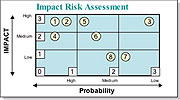
My BIG PICTURE email to Arun
"Arun, hi,
"Regarding ROI in the context that you give here (see above) one must look at providing 'solutions' to the client. Thus, the sales strategy is to ask the client 'what constitutes success for your product?'
"Have the client carefully, deliberately, and in detail, visualize and describe the elements of success. Presumably, those elements include being better than their competition on:
- Identifying and targeting customers
- Learning customer needs
- Creating desirable products with features and benefits competitors fail
to offer (Basically, 'eliminate the competition' by offering a unique, compelling
solution!) - Fulfilling follow-through for the client
- Excellent references and word of mouth
- Ability to sell on 'value' if the price cannot be as low as the competition
(after all, Mercedes cars DO sell to the right people!)
"NOW, with your homework done (all the above), you can help define the risk to your client if they fail or do not succeed on EACH of the above goals.
"Some of the goals are interlocked with other goals. Other goals are independent. But... you can use market size (from industry figures) to estimate the sales potential for the expected market share your client would want. Given market share (e.g., 30%) of say a market size of 300 million Euros (or whatever), gives you .3 X 300 million or 90 million Euros as a goal.
"Now, using feedback from the client, estimate how each of the above elements contributes to the 90 million Euros goal.
"The Euro losses due to failure represent the risk to your client if they use inferior design and testing.
"Your company can 'guarantee' they will not fail (using your methods you list). Thus, hiring your company is like buying 'insurance'. <I hasten to add, this is metaphorical. Unless you purchase insurance from Lloyds of London!>
"Your usability services offer 'risk mitigation' to your client.
"The next step is to determine the cost of what you feel to be the 'best' package to guarantee success.
"This is done with daily/hourly billable work rates your company should have. Those rates should include the profit your company expects to make per hour or per day for the service. You can also add in a 'value added' amount to represent the overall expertise your company brings to the table. You can even consider 'what the market will bear'. Of course, you also have to consider what a competing design firm might bid for the same work.
"But that's how it's done.
"In the final analysis, your presentation can show what you expect the company to earn, IF their product meets market demands. Then, for each usability step, you can show what they stand to 'lose' in revenue if they fail.
"This links each step of your proposal to a specific loss of revenue that would be weighed against the cost of the services your company would perform. This is 'ROI'.
"A more detailed ROI analysis at the 'operational level' is available at this HFI link.
"I'm sending this to a friend, Michael Rawlins, who has managed usability groups at several companies. (He called me in to teach several HFI courses)."
Now for the picture of the BIG PICTURE
I had a "secret weapon". Several years ago, Michael (now President, Connecticut Usability Professionals Association and Adjunct Professor, Manchester Community College, Manchester CT) had shown me his approach to internal marketing of UX.
He had a spreadsheet that gave his estimate of the % "risk" represented by each stage of product development if UX were to be eliminated! (The source of my secret weapon.)
I asked Michael for a copy of his visualization so that Arun could benefit.
Here's a portion of his spreadsheet from one of Michael's BIG PICTURE presentations. (Well, purely a reading experience, but it's an easy enough read.)
But better yet, was his picture of the BIG PICTURE.
The power of Michael's concept (assigning percentages of risk mitigation) was so powerful, that I remembered it years later to apply it to Arun's marketing challenge.
What do you think about this visualization? Does it help you factor the simultaneous business issues of "Probability" and "Impact"? I think so.
Guess what? This type of chart (top right) has a name. It's called the "Scenario Matrix" as illustrated here.
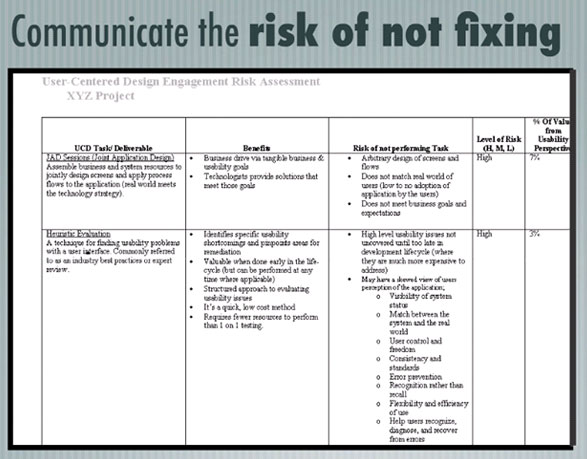
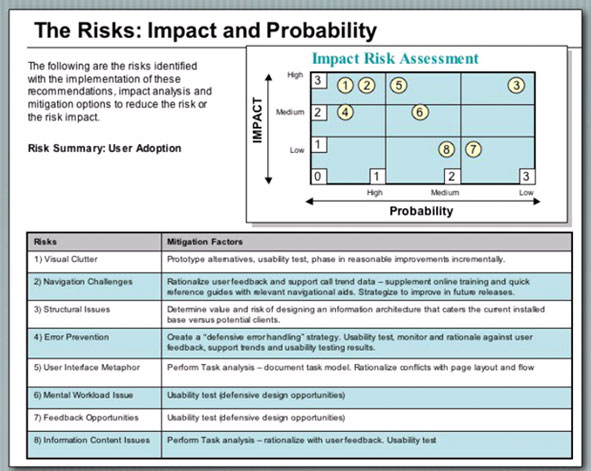
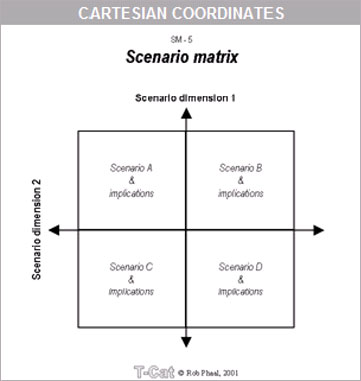

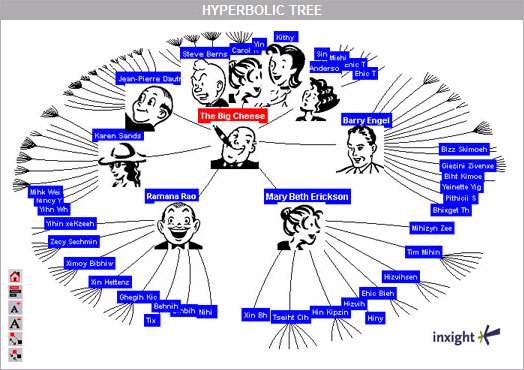
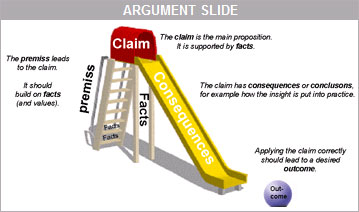
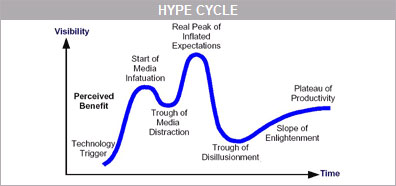
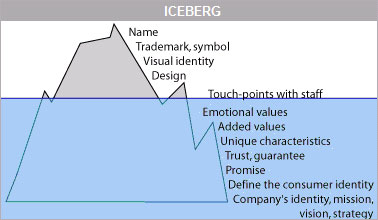

A treasure-trove of visualization ideas
This and other visualization methods are categorized in the "Periodic Table of Visualization Methods" by Ralph Lengler and Martin Eppler. Check out their site because it's interactive. When you mouse-over an element in their table, you get a pop-up example of the visualization method (as below).
The authors approach communication as a visualization challenge for business as well as science and engineering. From their 2007 conference paper, Toward A Periodic Table of Visualization Methods for Management:
"A visualization method is a systematic, rule-based, external, permanent and graphic representation that depicts information in a way that is conducive to acquiring insights, developing an elaborate understanding, or communicating experiences."
As you see in the chart (above), their taxonomy of 100 methods provides these 6 clusters...
1. Data: quantitative in schematic form (e.g., the Scenario Matrix we already saw).
2. Information: to amplify understanding and cognition. Make it interactive when possible.
3. Concept: elaborate qualitative ideas, plans, and analyses.
4. Strategy: to formulate and communicate strategies in organizations.
5. Metaphor: convey insights about the information with metaphor.
6. Compound: combined formats in one visualization.
Summary: using pictures for the BIG PICTURE
By now you get the idea that a BIG PICTURE on a topic can be obtained from a supporting, explanatory picture (or visualization).
That is, our visual "comprehension" of a picture aids the psychological "comprehension" as well.
As evidence, recall the research described in our Dec 2009 UI Review "User Experience" meets "Beauty is Truth, Truth of Beauty". People accept the aesthetic experience as a measure of valid reasoning!
Here are some other sites offering inspiration and instruction in visualization
1) Thinkbase ‚Äď topic mapping with node graphs. (Start typing a search topic and you'll see other goodies listed in the Search field.)
Let's return to our original topic: Arun's questions about UX Strategy.
How does Michael's visualization "resonate" with you?
For me, anyway, it presents the UX playing field. Insert all the elements of product development into Michael's chart, and you have mapped "the mine field" of business risk.
Which one do you want to step on? Take your pick.
Well, the rational observer would say "I don't want to risk anything ‚Äď except maybe the Low Impact, Low Probability quadrant.
That's what it's all about. Seeing is believing.
The BIG PICTURE gets discussed when you have the little picture that gets it right.
Get the picture?
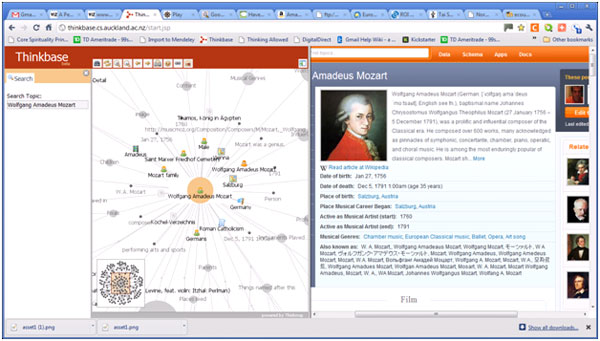
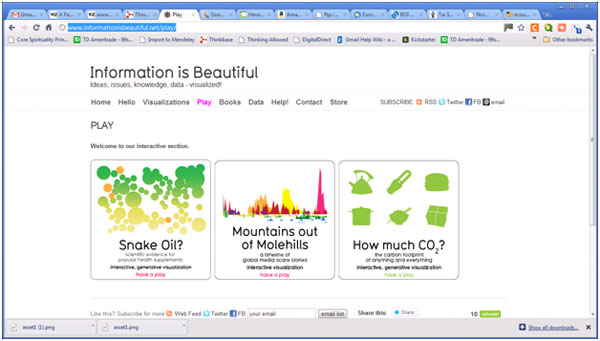
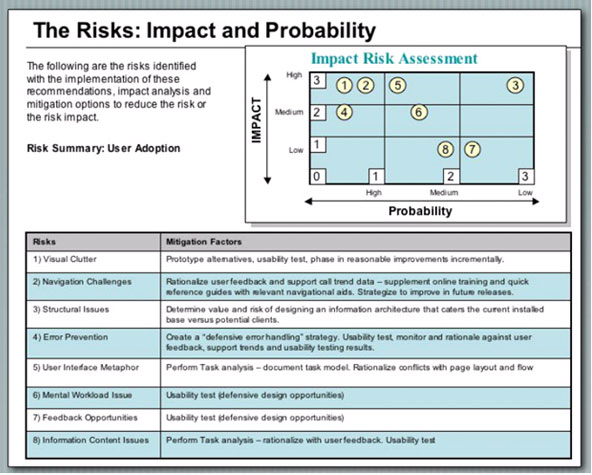
References
Ralph Lengler and Martin J. Eppler (2007). Towards a periodic table of visualization methods for management. In GVE 2007: Graphics and Visualization in Engineering. Acta Press.
There are many additional resources on visualization. Some examples to get you started. Check Amazon, too.
Robert L. Harris (1999). Information Graphics: A Comprehensive Illustrated Reference. Oxford University Press.
Melanie Tory and Torstem Moller (2004) Rethinking visualization: A high-level taxonomy. In IEEE Symposium on Information Visualization INFOVIS 2004. 151-158. IEEE CS Press.
Message from the CEO, Dr. Eric Schaffer ‚ÄĒ The Pragmatic Ergonomist
Leave a comment here
Subscribe
Sign up to get our Newsletter delivered straight to your inbox
Privacy policy
Reviewed: 18 Mar 2014
This Privacy Policy governs the manner in which Human Factors International, Inc., an Iowa corporation (‚ÄúHFI‚ÄĚ) collects, uses, maintains and discloses information collected from users (each, a ‚ÄúUser‚ÄĚ) of its humanfactors.com website and any derivative or affiliated websites on which this Privacy Policy is posted (collectively, the ‚ÄúWebsite‚ÄĚ). HFI reserves the right, at its discretion, to change, modify, add or remove portions of this Privacy Policy at any time by posting such changes to this page. You understand that you have the affirmative obligation to check this Privacy Policy periodically for changes, and you hereby agree to periodically review this Privacy Policy for such changes. The continued use of the Website following the posting of changes to this Privacy Policy constitutes an acceptance of those changes.
Cookies
HFI may use ‚Äúcookies‚ÄĚ or ‚Äúweb beacons‚ÄĚ to track how Users use the Website. A cookie is a piece of software that a web server can store on Users‚Äô PCs and use to identify Users should they visit the Website again. Users may adjust their web browser software if they do not wish to accept cookies. To withdraw your consent after accepting a cookie, delete the cookie from your computer.
Privacy
HFI believes that every User should know how it utilizes the information collected from Users. The Website is not directed at children under 13 years of age, and HFI does not knowingly collect personally identifiable information from children under 13 years of age online. Please note that the Website may contain links to other websites. These linked sites may not be operated or controlled by HFI. HFI is not responsible for the privacy practices of these or any other websites, and you access these websites entirely at your own risk. HFI recommends that you review the privacy practices of any other websites that you choose to visit.
HFI is based, and this website is hosted, in the United States of America. If User is from the European Union or other regions of the world with laws governing data collection and use that may differ from U.S. law and User is registering an account on the Website, visiting the Website, purchasing products or services from HFI or the Website, or otherwise using the Website, please note that any personally identifiable information that User provides to HFI will be transferred to the United States. Any such personally identifiable information provided will be processed and stored in the United States by HFI or a service provider acting on its behalf. By providing your personally identifiable information, User hereby specifically and expressly consents to such transfer and processing and the uses and disclosures set forth herein.
In the course of its business, HFI may perform expert reviews, usability testing, and other consulting work where personal privacy is a concern. HFI believes in the importance of protecting personal information, and may use measures to provide this protection, including, but not limited to, using consent forms for participants or ‚Äúdummy‚ÄĚ test data.
The Information HFI Collects
Users browsing the Website without registering an account or affirmatively providing personally identifiable information to HFI do so anonymously. Otherwise, HFI may collect personally identifiable information from Users in a variety of ways. Personally identifiable information may include, without limitation, (i)contact data (such as a User’s name, mailing and e-mail addresses, and phone number); (ii)demographic data (such as a User’s zip code, age and income); (iii) financial information collected to process purchases made from HFI via the Website or otherwise (such as credit card, debit card or other payment information); (iv) other information requested during the account registration process; and (v) other information requested by our service vendors in order to provide their services. If a User communicates with HFI by e-mail or otherwise, posts messages to any forums, completes online forms, surveys or entries or otherwise interacts with or uses the features on the Website, any information provided in such communications may be collected by HFI. HFI may also collect information about how Users use the Website, for example, by tracking the number of unique views received by the pages of the Website, or the domains and IP addresses from which Users originate. While not all of the information that HFI collects from Users is personally identifiable, it may be associated with personally identifiable information that Users provide HFI through the Website or otherwise. HFI may provide ways that the User can opt out of receiving certain information from HFI. If the User opts out of certain services, User information may still be collected for those services to which the User elects to subscribe. For those elected services, this Privacy Policy will apply.
How HFI Uses Information
HFI may use personally identifiable information collected through the Website for the specific purposes for which the information was collected, to process purchases and sales of products or services offered via the Website if any, to contact Users regarding products and services offered by HFI, its parent, subsidiary and other related companies in order to otherwise to enhance Users’ experience with HFI. HFI may also use information collected through the Website for research regarding the effectiveness of the Website and the business planning, marketing, advertising and sales efforts of HFI. HFI does not sell any User information under any circumstances.
Disclosure of Information
HFI may disclose personally identifiable information collected from Users to its parent, subsidiary and other related companies to use the information for the purposes outlined above, as necessary to provide the services offered by HFI and to provide the Website itself, and for the specific purposes for which the information was collected. HFI may disclose personally identifiable information at the request of law enforcement or governmental agencies or in response to subpoenas, court orders or other legal process, to establish, protect or exercise HFI’s legal or other rights or to defend against a legal claim or as otherwise required or allowed by law. HFI may disclose personally identifiable information in order to protect the rights, property or safety of a User or any other person. HFI may disclose personally identifiable information to investigate or prevent a violation by User of any contractual or other relationship with HFI or the perpetration of any illegal or harmful activity. HFI may also disclose aggregate, anonymous data based on information collected from Users to investors and potential partners. Finally, HFI may disclose or transfer personally identifiable information collected from Users in connection with or in contemplation of a sale of its assets or business or a merger, consolidation or other reorganization of its business.
Personal Information as Provided by User
If a User includes such User’s personally identifiable information as part of the User posting to the Website, such information may be made available to any parties using the Website. HFI does not edit or otherwise remove such information from User information before it is posted on the Website. If a User does not wish to have such User’s personally identifiable information made available in this manner, such User must remove any such information before posting. HFI is not liable for any damages caused or incurred due to personally identifiable information made available in the foregoing manners. For example, a User posts on an HFI-administered forum would be considered Personal Information as provided by User and subject to the terms of this section.
Security of Information
Information about Users that is maintained on HFI’s systems or those of its service providers is protected using industry standard security measures. However, no security measures are perfect or impenetrable, and HFI cannot guarantee that the information submitted to, maintained on or transmitted from its systems will be completely secure. HFI is not responsible for the circumvention of any privacy settings or security measures relating to the Website by any Users or third parties.
Correcting, Updating, Accessing or Removing Personal Information
If a User’s personally identifiable information changes, or if a User no longer desires to receive non-account specific information from HFI, HFI will endeavor to provide a way to correct, update and/or remove that User’s previously-provided personal data. This can be done by emailing a request to HFI at hfi@humanfactors.com. Additionally, you may request access to the personally identifiable information as collected by HFI by sending a request to HFI as set forth above. Please note that in certain circumstances, HFI may not be able to completely remove a User’s information from its systems. For example, HFI may retain a User’s personal information for legitimate business purposes, if it may be necessary to prevent fraud or future abuse, for account recovery purposes, if required by law or as retained in HFI’s data backup systems or cached or archived pages. All retained personally identifiable information will continue to be subject to the terms of the Privacy Policy to which the User has previously agreed.
Contacting HFI
If you have any questions or comments about this Privacy Policy, you may contact HFI via any of the following methods:
Human Factors International, Inc.
PO Box 2020
1680 highway 1, STE 3600
Fairfield IA 52556
hfi@humanfactors.com
(800) 242-4480
Terms and Conditions for Public Training Courses
Reviewed: 18 Mar 2014
Cancellation of Course by HFI
HFI reserves the right to cancel any course up to 14 (fourteen) days prior to the first day of the course. Registrants will be promptly notified and will receive a full refund or be transferred to the equivalent class of their choice within a 12-month period. HFI is not responsible for travel expenses or any costs that may be incurred as a result of cancellations.
Cancellation of Course by Participants (All regions except India)
$100 processing fee if cancelling within two weeks of course start date.
Cancellation / Transfer by Participants (India)
4 Pack + Exam registration: Rs. 10,000 per participant processing fee (to be paid by the participant) if cancelling or transferring the course (4 Pack-CUA/CXA) registration before three weeks from the course start date. No refund or carry forward of the course fees if cancelling or transferring the course registration within three weeks before the course start date.
Cancellation / Transfer by Participants (Online Courses)
$100 processing fee if cancelling within two weeks of course start date. No cancellations or refunds less than two weeks prior to the first course start date.
Individual Modules: Rs. 3,000 per participant ‚Äėper module‚Äô processing fee (to be paid by the participant) if cancelling or transferring the course (any Individual HFI course) registration before three weeks from the course start date. No refund or carry forward of the course fees if cancelling or transferring the course registration within three weeks before the course start date.
Exam: Rs. 3,000 per participant processing fee (to be paid by the participant) if cancelling or transferring the pre agreed CUA/CXA exam date before three weeks from the examination date. No refund or carry forward of the exam fees if requesting/cancelling or transferring the CUA/CXA exam within three weeks before the examination date.
No Recording Permitted
There will be no audio or video recording allowed in class. Students who have any disability that might affect their performance in this class are encouraged to speak with the instructor at the beginning of the class.
Course Materials Copyright
The course and training materials and all other handouts provided by HFI during the course are published, copyrighted works proprietary and owned exclusively by HFI. The course participant does not acquire title nor ownership rights in any of these materials. Further the course participant agrees not to reproduce, modify, and/or convert to electronic format (i.e., softcopy) any of the materials received from or provided by HFI. The materials provided in the class are for the sole use of the class participant. HFI does not provide the materials in electronic format to the participants in public or onsite courses.


